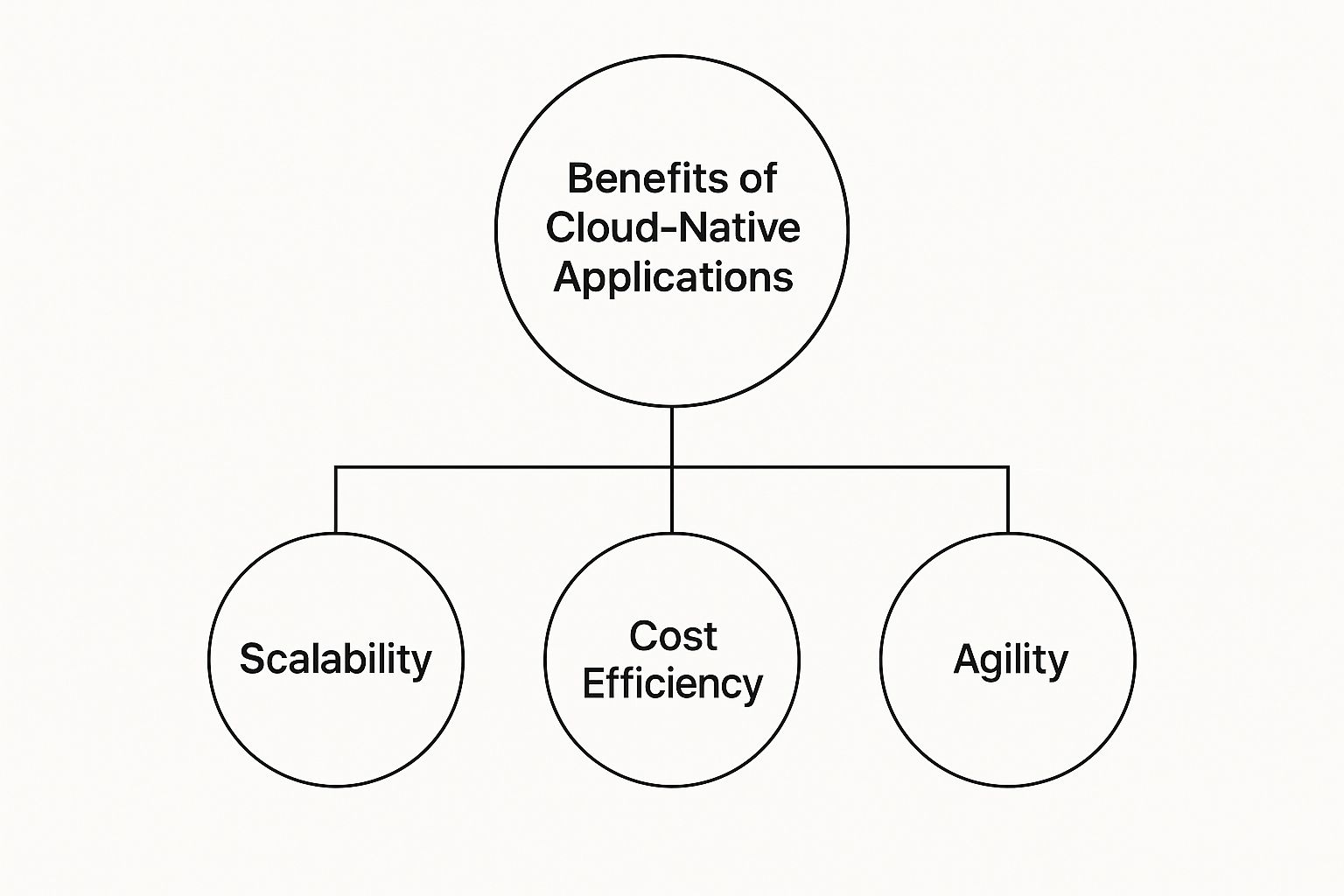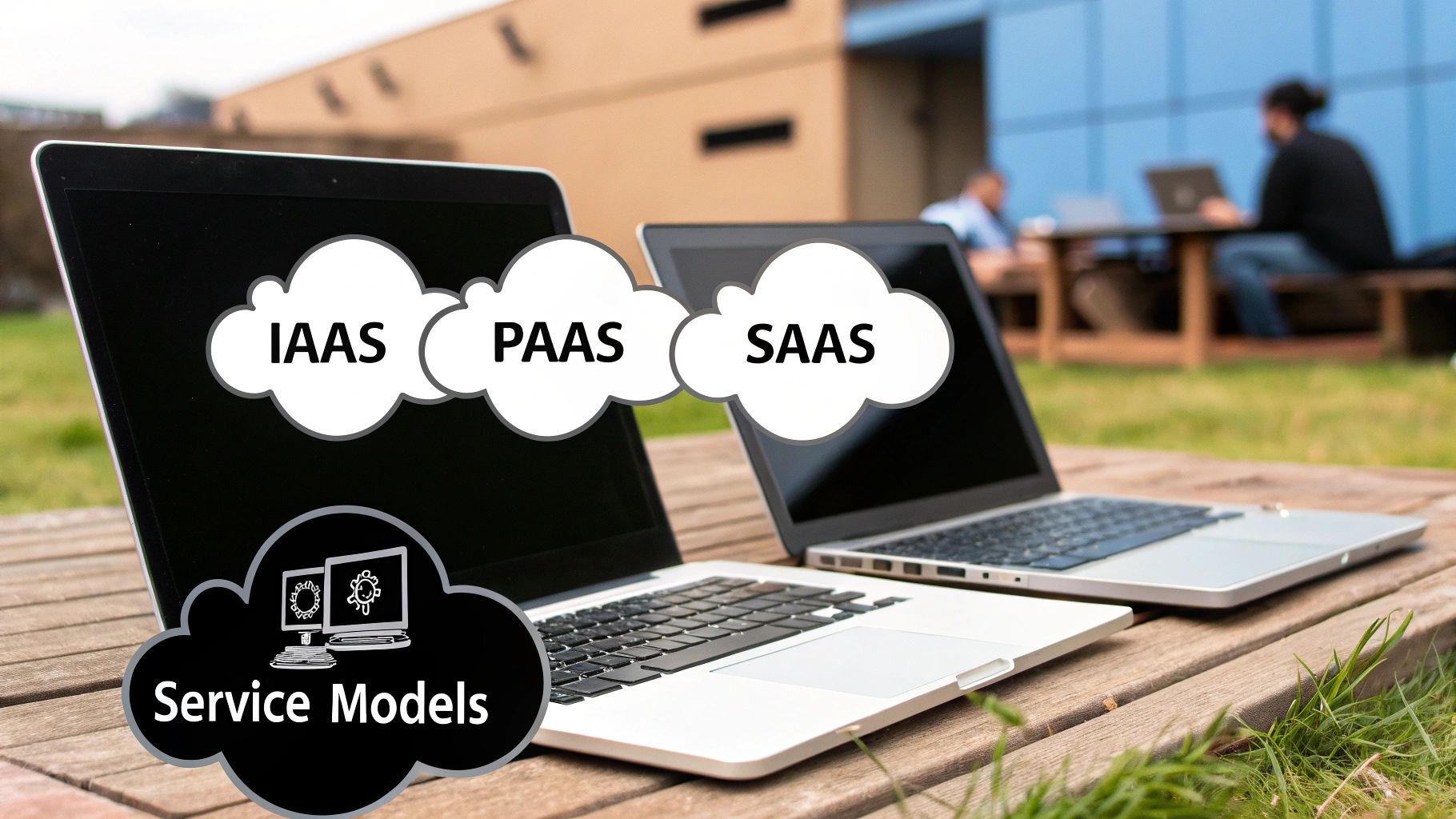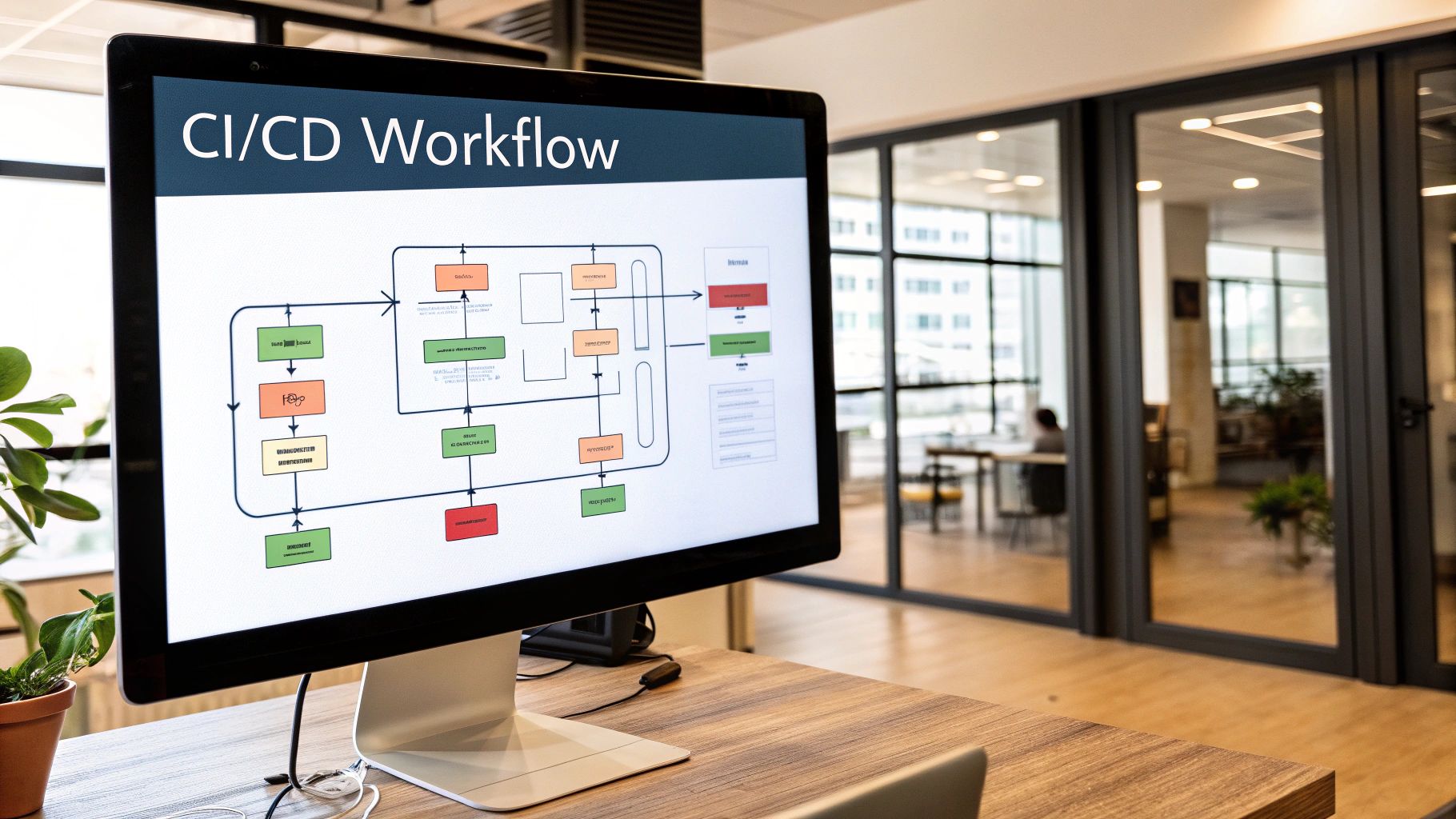In the not-so-distant past, application development followed a straightforward script: you designed, built, and deployed software on your own local servers. Today, that script has been completely rewritten. Modern application development and cloud computing are inextricably linked, creating a new paradigm built on cloud infrastructure. This gives development teams on-demand access to a vast repository of resources—computing power, storage, and databases—resulting in applications that are more scalable, resilient, and cost-effective than ever before.
The New Reality of Building Software in the Cloud

The era of building software on rigid, on-premise hardware is decisively over. Forward-thinking development teams now operate within a dynamic, resource-rich ecosystem powered entirely by the cloud. This evolution hasn't just tweaked development methods; it has fundamentally reshaped the entire lifecycle, from initial concept to global deployment.
Consider this analogy. The traditional method of software development was akin to constructing a skyscraper from scratch. You had to purchase the land, procure every building material upfront, and maintain a full construction crew on payroll, regardless of the project phase. This approach demanded enormous capital investment and was fraught with risk. If your architectural plans changed midway? You were left with a surplus of materials and a team you couldn't efficiently downsize.
Now, contrast that with the modern approach of application development in cloud computing. It’s like having an infinite supply of building blocks, delivered precisely when you need them. Require more steel beams for an additional floor? They arrive instantly. Need a specialised crane for a single week? You rent it, use it, and return it. This model provides unparalleled freedom to build, pivot, and scale without being shackled to heavy, sunk costs.
Why This Shift Is Critical for Your Business
This is more than a technical upgrade; it's a strategic imperative. Building in the cloud enables organisations to accelerate innovation, test new ideas with minimal financial exposure, and respond to market dynamics with genuine agility. Because you can provision resources almost instantly, development cycles contract, and new features reach your customers much sooner. This is the bedrock upon which high-performing, competitive teams build their success.
The economic impact is undeniable. The UK cloud computing market has already reached a valuation of approximately USD 27.48 billion. And its momentum is only increasing. Projections show that figure soaring to an impressive USD 97.21 billion by 2033, driven by the relentless demand for scalable and efficient IT solutions. This explosive growth underscores how central the cloud has become to modern business operations.
At its core, cloud development transforms software creation from a capital-intensive project into a flexible, operational activity. It allows businesses to align technology spending directly with their growth, paying only for the resources they actually use.
By embracing this new reality, companies can refocus on what truly matters: creating brilliant web applications that solve genuine customer problems and drive business growth. Understanding exactly what a web application is and how it can benefit your business is an excellent starting point. If you're new to the concept, you may find our guide on what a web application is and why you need one particularly insightful. This modern approach truly sets the stage for everything that follows in advanced software engineering.
Choosing Your Cloud Service Model: IaaS, PaaS & SaaS
Embarking on cloud application development means navigating a landscape of service models, most commonly known by their acronyms: IaaS, PaaS, and SaaS. Understanding the practical differences between these models is one of the first and most critical decisions your development team will make. It dictates the balance between control, responsibility, and speed.
Think of it as deciding how to prepare a meal. Each model offers a different level of pre-preparedness, and the optimal choice depends on your objective and your team's expertise.
Infrastructure as a Service (IaaS): The Professional Kitchen
Infrastructure as a Service (IaaS) is analogous to being given the keys to a professional-grade kitchen. The cloud provider supplies the fundamental hardware—the ovens (servers), refrigerators (storage), and plumbing (networking). From there, you have complete control.
This means your team is responsible for managing everything else: installing the operating system, configuring databases, and managing all software runtimes. IaaS offers the greatest flexibility and control, making it ideal for complex, highly specialised applications with unique infrastructure requirements. However, this level of control inherently comes with the highest management overhead.
Platform as a Service (PaaS): The Meal Kit
Platform as a Service (PaaS) is the cloud equivalent of a meal-kit delivery service. The provider delivers a box with the core ingredients ready to go—the pizza dough, sauce, and toppings are prepared. They also manage the oven and ensure it's preheated to the perfect temperature. Your role is to assemble the pizza and bake it.
In development terms, the provider manages the servers, networking, storage, and the operating system. They provide a platform with integrated development tools, database services, and runtime environments. This is a significant productivity enhancer, as it allows your developers to focus purely on writing code and building features, dramatically reducing development and deployment times. It represents an excellent balance, enabling rapid market entry without sacrificing the ability to build a custom application.

As you can see, building on these platforms gives your team some serious advantages in scalability, cost-effectiveness, and agility—all direct results of picking the right service model for the job.
Software as a Service (SaaS): The Delivered Pizza
Finally, there’s Software as a Service (SaaS), which is like ordering a piping hot pizza delivered directly to your door. You don’t concern yourself with the ingredients, the kitchen, or the chef. You simply open the box and enjoy the finished product.
From a user's perspective, SaaS applications are ready-made software accessed over the internet, such as Gmail or Slack. There is no development work required from the end-user. The provider manages everything, from the underlying infrastructure right up to the application's features and updates. The growth in this sector has been phenomenal. The UK cloud computing market generated revenues of around USD 47.24 billion, with SaaS as the dominant force, and that figure is projected to reach USD 135.24 billion by 2030.
To clarify how these models distribute responsibilities between you and the provider, here’s a concise breakdown.
Developer's Guide to Cloud Service Models
This table illustrates what you manage versus what the provider manages for each model, which should help you determine the best fit for your project.
Ultimately, choosing between IaaS, PaaS, and SaaS isn't about determining which one is "best." It's about selecting the model that aligns with your project's objectives, your team's capabilities, and your required speed to market.
This decision is a cornerstone of your project's foundation, directly influencing your architecture, budget, and timeline. It’s a crucial piece of your tech strategy, and getting it right pays significant dividends down the road. To dig deeper into this foundational step, check out our guide on how to choose the tech stack for your project.
Essential Cloud Architecture Patterns

Once you’ve selected your cloud service model, the next step is to examine the architectural blueprints. Building a superior application in the cloud isn't merely about using powerful tools; it’s about assembling them in a way that is both resilient and adaptable. We are moving far beyond simply "lifting and shifting" a legacy application onto a new server.
This shift in mindset is pervasive. A remarkable 84% of UK enterprises now adopt a 'cloud smart' strategy. This means they are making deliberate, strategic decisions about where to host different components of their applications to achieve optimal performance, whether in a private data centre, a public cloud, or at the network edge. This reflects a growing maturity in balancing cost, security, and operational efficiency.
The Microservices Approach for Unmatched Flexibility
Imagine a traditional, monolithic application as a large, interconnected office building. If the plumbing fails in one washroom, the water supply must be shut off for the entire building, disrupting everyone. It’s a logistical challenge to upgrade or repair one part without causing widespread chaos.
Microservices architecture demolishes that monolithic structure and rebuilds it as a campus of smaller, independent buildings. Each building—or service—is responsible for a single business function. For an e-commerce application, this might mean the product catalogue, the shopping cart, and the payment system are all separate, self-contained services.
This decoupling is incredibly powerful. If the payment service experiences a surge in traffic during a sale, you can scale only that service without affecting the rest of the application. Developers can also update or even replace one service entirely without redeploying the whole system, making development cycles faster and significantly less risky.
Serverless Computing for Event-Driven Efficiency
What if you only needed to execute a piece of code for a fraction of a second, and only when a specific event occurs? That is the simple yet brilliant premise behind Serverless Computing. Despite the name, servers are still involved; the key difference is that you never have to provision or manage them. The cloud provider handles all the infrastructure, and you are billed only for the precise compute time your code consumes.
A classic use case is an automated image processor. When a user uploads a new profile picture, that upload event can trigger a serverless function. This function instantly resizes the image into various thumbnail formats, saves them, and then shuts down completely.
Serverless is the ultimate "pay-for-what-you-use" model. It's perfectly suited for tasks that are infrequent or have unpredictable traffic patterns, as it eliminates the cost and hassle of keeping a server running 24/7 just in case it's needed.
Containerisation with Docker and Kubernetes
One of the most persistent challenges in software development is the "it works on my machine" problem. An application runs flawlessly on a developer's laptop but fails when deployed to a testing or production server due to subtle environmental differences.
Containerisation provides a definitive solution. Using a tool like Docker, developers package an application with all its dependencies—libraries, configuration files, and runtimes—into a single, lightweight unit called a container. This container will run identically, regardless of its deployment environment.
But what happens when you need to manage hundreds or thousands of these containers? That’s where Kubernetes comes in. It is the industry-standard orchestration platform, or "air traffic controller," for your containers, automatically handling complex tasks such as:
- Deployment: Rolling out new versions of your application seamlessly.
- Scaling: Adding or removing containers in response to real-time demand.
- Self-healing: Detecting and replacing failed containers automatically.
When planning your cloud architecture, investigating advanced deployment models is crucial for maintaining stability and enabling seamless updates. A prime example is the Blue Green Deployment strategy, which allows you to launch new application versions with zero downtime.
These patterns—Microservices, Serverless, and Containerisation—are not mutually exclusive. In fact, the most powerful cloud-native applications often integrate them to create highly efficient, scalable, and resilient systems.
The Strategic Business Value of Cloud Development
While it's easy to become engrossed in the technical details of architectural patterns and service models, the true power of application development in cloud computing is realised on the balance sheet. Migrating to the cloud is far more than a simple technology refresh; it's a strategic pivot that unlocks significant business value and provides a formidable competitive edge.
The most immediate and tangible benefit is financial. In the era of on-premise development, organisations had to allocate a substantial portion of their budget to Capital Expenditure (CapEx). This involved purchasing powerful servers, networking equipment, and storage arrays—expensive hardware that began depreciating the moment it was installed.
The cloud completely inverts this model, transforming these large upfront investments into predictable Operational Expenses (OpEx). Instead of buying the entire factory, you are effectively renting the specific machinery you need, precisely when you need it. This pay-as-you-go model liberates a significant amount of capital that can be reinvested into core business drivers: marketing, product innovation, and talent acquisition.
From Cost Centre to Growth Engine
This financial shift does more than improve cash flow; it fundamentally alters the approach to innovation. With an OpEx model, the risk associated with experimenting with a new application or feature plummets. You can provision a development environment, build a prototype, and gather user feedback without committing to a five-figure hardware purchase.
If the idea fails to gain traction? You simply de-provision the resources and cease payment. This agility allows businesses to experiment without fear, test more ideas, and ultimately arrive at a winning product much faster than competitors constrained by a capital-heavy mindset.
Elasticity and Market Responsiveness
One of the cloud's most powerful business advantages is elasticity—its remarkable ability to automatically scale resources up or down to match demand in real time.
Consider a retail company preparing for a major Black Friday sale. In the on-premise world, they would need to own enough server capacity to handle that single, massive traffic peak. For the other 364 days of the year, most of that expensive infrastructure would sit idle.
In the cloud, the application can scale up instantly to accommodate the influx of shoppers and then scale back down just as quickly once the event concludes. This not only prevents website crashes and customer frustration but also ensures the business only pays for peak capacity when it is actually being used.
This isn't just about preventing system failures; it's about seizing opportunity. By reliably handling traffic surges, businesses can maximise revenue during critical events, build customer trust, and enhance their brand reputation.
For many businesses, achieving this requires the right team. As you grow, understanding how to go about successfully outsourcing a cloud development team can be a game-changer for accessing specialist skills and scaling your development capacity on demand.
Slashing Time-to-Market with DevOps
Finally, the cloud provides the ideal environment for modern DevOps practices. By uniting development and operations teams on a single platform, businesses can automate nearly every aspect of the software lifecycle, from code testing to deployment. This creates a highly efficient CI/CD (Continuous Integration/Continuous Delivery) pipeline that drastically shortens development cycles.
Instead of stressful, high-risk "big bang" releases every six months, teams can push small, incremental updates multiple times a day. This delivers new features to customers faster, reduces the risk of introducing major bugs, and makes resolving any issues that do arise significantly easier.
When you can innovate and adapt faster than your competition, you’re not just building software—you’re building market leadership. You can see how these benefits apply particularly well to custom-built solutions by reading our guide on what bespoke software development entails.
Proven Best Practices for Modern Cloud Development

Understanding cloud architecture is one thing; implementing it with professional discipline is another entirely. The principles that distinguish a weekend project from an enterprise-grade cloud application are not secret formulas but non-negotiable best practices. They are the standards our teams live by to deliver secure, efficient, and resilient solutions for every client.
Mastering application development in cloud computing is about more than just adopting the latest tools. It's about embedding quality, security, and cost-consciousness into your development culture from day one. These disciplines ensure you not only build a great application but can also operate it successfully for years to come.
Automate Everything With a Solid CI/CD Pipeline
The days of a developer nervously clicking "deploy" on a Friday afternoon are over—or at least, they should be. A modern cloud workflow must be built on a robust foundation of Continuous Integration and Continuous Delivery (CI/CD). This automated pipeline is the engine that drives both speed and quality.
Think of it as an automated quality control and logistics line for your code. The moment a developer commits a change, the CI/CD pipeline is triggered:
- Build the Application: It compiles the new code and packages it for deployment.
- Run Automated Tests: A comprehensive suite of tests—from unit tests to end-to-end integration tests—is executed to catch bugs before they reach users.
- Deploy to Staging: The new version is pushed to a staging environment, an identical replica of your production system, for final validation.
- Release to Production: Once all checks pass, the update is rolled out to customers seamlessly, often with zero downtime.
This level of automation virtually eliminates human error, liberates developers from repetitive manual tasks, and drastically reduces the time-to-market for new features. It is arguably the single most important practice for achieving both agility and reliability.
Prioritise Security From Day One
In the cloud, security cannot be an afterthought. It must be woven into the very fabric of your application from the first line of code. Attempting to secure a completed product is like trying to install a fire alarm after a house has been built—it’s inefficient, expensive, and never as effective.
One of the most critical components of cloud security is Identity and Access Management (IAM). Your IAM policies act as the digital gatekeepers for all your cloud resources, defining precisely who can access what, and under which conditions.
Your guiding principle here should be the principle of least privilege. This means granting users, services, and applications the absolute minimum permissions required to perform their designated functions. Nothing more. This simple rule dramatically reduces your attack surface and contains the potential damage if an account is ever compromised.
Furthermore, data protection is non-negotiable. This involves implementing end-to-end data encryption. Your data must be encrypted both when it is stored (at rest in a database) and when it is being transferred (in transit between services). Modern cloud providers make this remarkably straightforward, leaving no excuse for exposing sensitive information.
Master Cloud Cost Management
The cloud's pay-as-you-go model offers incredible flexibility, but it can also lead to significant bill shock if not managed diligently. A primary reason many cloud projects fail to deliver their promised ROI is a lack of cost discipline. This is where battle-tested strategies for managing your cloud expenditure become critical.
Begin with the tools your cloud provider offers. Services like AWS Cost Explorer or Azure Cost Management provide detailed dashboards to help you visualise where your money is going. Visibility is the first step. Next, implement a rigorous tagging strategy—label every resource with its associated project, team, or cost centre. This fosters accountability and eliminates guesswork.
To ensure your projects are of the highest standard, it's vital to adhere to core essential app development best practices, which cover everything from architecture to security. By actively managing your costs, you can prevent budget overruns and ensure your cloud investment delivers a clear, positive return for the business.
Now, let's connect these threads and see how they apply in a real-world scenario. Theory is valuable, but seeing how cloud development principles play out in practice is where true understanding solidifies.
Building a Smart Home App: From Concept to Cloud
Let's walk through the process of building a smart home management application. This is a classic, practical project: we want to enable users to control their lights, monitor security cameras, and track energy usage, all from their smartphone, anywhere in the world.
This example provides the perfect opportunity to demonstrate how the service models, architectures, and best practices we've discussed are not abstract theories, but practical tools that converge to create something tangible and valuable.
Phase 1: Laying the Foundation with PaaS
First and foremost, we need to get up and running quickly without getting mired in server configuration. At the outset, speed is paramount.
This is where a Platform as a Service (PaaS) like Heroku or AWS Elastic Beanstalk becomes an invaluable asset. Opting for a PaaS allows us to bypass the tedious and time-consuming task of configuring operating systems, web servers, or databases. The platform handles it all. This liberates our developers to focus on their core competency: writing the code that brings our app to life.
It's the ideal launchpad. We get a managed environment that handles the underlying infrastructure, while retaining full freedom to build our custom application on top. It’s the fast track to getting a product to market.
Phase 2: Architecting for Scale with Microservices
Instead of building a single, monolithic application, we will adopt a more intelligent microservices architecture. Each core feature of our smart home app will be its own small, independent service.
The structure will look something like this:
- Lighting Service: This service is solely responsible for turning lights on and off, managing schedules, and adjusting brightness.
- Security Service: This service handles all camera-related functions—live video streams, motion detection alerts, and access logs.
- Energy Service: Its only job is to track electricity consumption from smart plugs and generate insightful usage reports.
This is not merely an organisational preference; it's a strategic decision. If we want to introduce a new colour-cycling feature for the lights, we only need to modify the Lighting Service. The rest of the application remains completely untouched. It also means we can scale each component independently. If a user adds ten new cameras, we can allocate more resources to the Security Service without impacting the others.
By decomposing the application into these smaller, self-contained units, we build in resilience and agility from day one. An issue in one service won't bring down the entire system, leading to a much more reliable user experience.
Phase 3: Implementing Event-Driven Actions with Serverless
Now for the sophisticated part. How does the app react to events in real time? What happens when a camera detects motion at the front door? We could have a server running 24/7, constantly polling for an event, but that would be highly inefficient and cost-prohibitive.
This is the perfect use case for serverless functions.
We can configure a tiny, single-purpose function that is triggered by an event—in this case, the "motion detected" event from our Security Service. When that event fires, the function spins up, performs its one job (sending a push notification to the user's phone), and then immediately shuts down.
The efficiency gained here is extraordinary. We are billed only for the fraction of a second that the function is actually running. For handling thousands of these small, event-driven actions, it is an unbelievably cost-effective approach. And just like that, we have integrated our service model (PaaS), architecture (microservices), and a core best practice (serverless) into a powerful, functional system.
Frequently Asked Questions
As teams transition to the cloud, many questions inevitably arise. It's a significant shift, after all. To provide you with a head start, we've compiled answers to some of the most common queries we receive about application development in cloud computing.
How Do I Choose the Right Cloud Provider for My Application?
Selecting between the major providers like AWS, Azure, or Google Cloud Platform depends entirely on your specific circumstances. There is no single “best” choice for every organisation.
Several factors should be considered. What is your team's existing skill set? Are they already proficient with a particular provider's tools? Do you require specialised services, such as advanced AI or machine learning capabilities, where one provider might have an edge? And, of course, you must compare their pricing models and ensure they meet any industry-specific compliance requirements you may have.
A prudent approach is to start small. Select a non-critical project and use it as a pilot to test-drive a provider's platform. This gives you first-hand experience with their ecosystem before making a large-scale commitment.
What Is the Difference Between Cloud-Native and Cloud-Hosted?
This is a critical distinction that often causes confusion.
Cloud-hosted essentially means taking an existing application and moving it to run on cloud infrastructure—a process often referred to as "lift-and-shift." It's analogous to moving your existing furniture into a new, larger house. It works, and you gain some immediate benefits like outsourced hardware management, but you are not fully leveraging the unique capabilities of the new environment.
Cloud-native, in contrast, involves designing and building an application from the ground up specifically for the cloud. It is architected from day one to leverage concepts like microservices, containers, and serverless functions. These applications are inherently more flexible, resilient, and can adapt to change much more rapidly.
A cloud-hosted app lives in the cloud. A cloud-native app was born in it, speaks its language, and is designed to thrive there.
How Can I Manage Costs Effectively in the Cloud?
Controlling cloud expenditure is not about magic; it's about discipline. It comes down to three key practices: gaining visibility into your spending, establishing accountability, and continuously optimising for efficiency.
- Gain a clear view: First, you must understand what you're spending and where. Utilise the dashboards and tools provided by your cloud provider to get a transparent view of your costs. This eliminates guesswork.
- Create accountability: Next, implement a rigorous tagging policy for all your cloud resources. Assign each resource to a specific project, team, or department. When teams are aware of their portion of the bill, they tend to be more judicious with resource consumption.
- Optimise, optimise, optimise: Finally, make optimisation a continuous process. Are your instances right-sized for their workloads, or are you paying for underutilised capacity? Employ auto-scaling to manage peak periods without overprovisioning full-time. For non-time-sensitive tasks, explore more cost-effective options like serverless functions or spot instances.
At Make IT Simple, we've spent over two decades turning innovative ideas into robust, market-ready SaaS platforms. Our experience is your advantage. Book a consultation today to explore how we can bring your cloud application vision to life with guaranteed costs and delivery timelines. Discover more at https://www.makeitsimple.co.uk.


